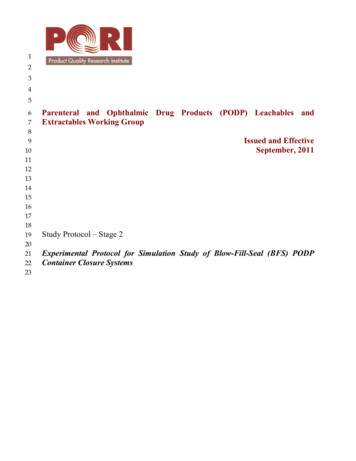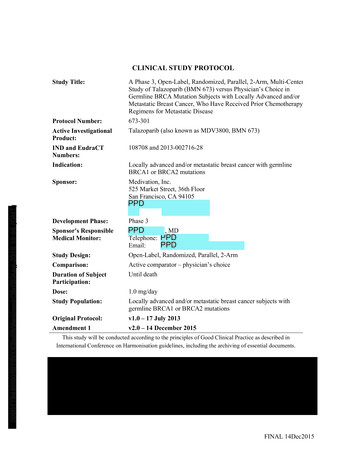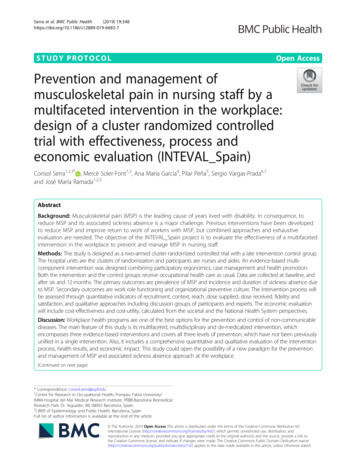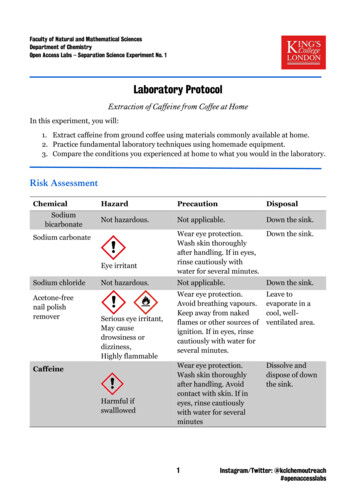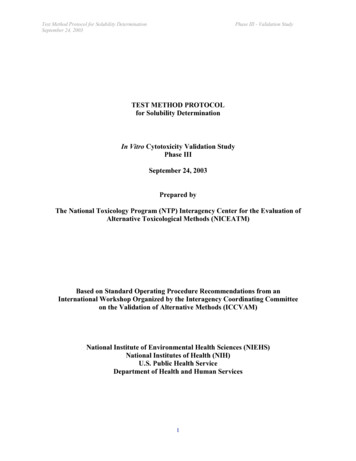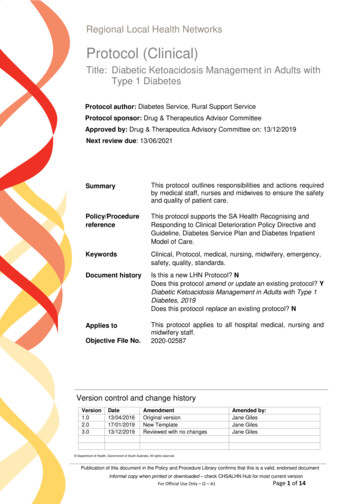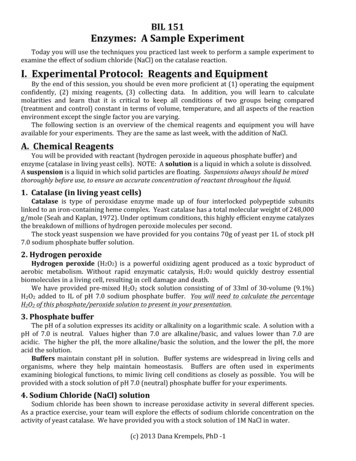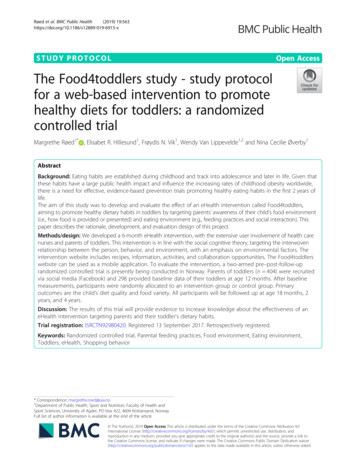
Transcription
Røed et al. BMC Public Health(2019) DY PROTOCOLOpen AccessThe Food4toddlers study - study protocolfor a web-based intervention to promotehealthy diets for toddlers: a randomizedcontrolled trialMargrethe Røed1* , Elisabet R. Hillesund1, Frøydis N. Vik1, Wendy Van Lippevelde1,2 and Nina Cecilie Øverby1AbstractBackground: Eating habits are established during childhood and track into adolescence and later in life. Given thatthese habits have a large public health impact and influence the increasing rates of childhood obesity worldwide,there is a need for effective, evidence-based prevention trials promoting healthy eating habits in the first 2 years oflife.The aim of this study was to develop and evaluate the effect of an eHealth intervention called Food4toddlers,aiming to promote healthy dietary habits in toddlers by targeting parents’ awareness of their child’s food environment(i.e., how food is provided or presented) and eating environment (e.g., feeding practices and social interaction). Thispaper describes the rationale, development, and evaluation design of this project.Methods/design: We developed a 6-month eHealth intervention, with the extensive user involvement of health carenurses and parents of toddlers. This intervention is in line with the social cognitive theory, targeting the interwovenrelationship between the person, behavior, and environment, with an emphasis on environmental factors. Theintervention website includes recipes, information, activities, and collaboration opportunities. The Food4toddlerswebsite can be used as a mobile application. To evaluate the intervention, a two-armed pre–post-follow-uprandomized controlled trial is presently being conducted in Norway. Parents of toddlers (n 404) were recruitedvia social media (Facebook) and 298 provided baseline data of their toddlers at age 12 months. After baselinemeasurements, participants were randomly allocated to an intervention group or control group. Primaryoutcomes are the child’s diet quality and food variety. All participants will be followed up at age 18 months, 2years, and 4 years.Discussion: The results of this trial will provide evidence to increase knowledge about the effectiveness of aneHealth intervention targeting parents and their toddler’s dietary habits.Trial registration: ISRCTN92980420. Registered 13 September 2017. Retrospectively registered.Keywords: Randomized controlled trial, Parental feeding practices, Food environment, Eating environment,Toddlers, eHealth, Shopping behavior* Correspondence: margrethe.roed@uia.no1Department of Public Health, Sport and Nutrition, Faculty of Health andSport Sciences, University of Agder, PO box 422, 4604 Kristiansand, NorwayFull list of author information is available at the end of the article The Author(s). 2019 Open Access This article is distributed under the terms of the Creative Commons Attribution 4.0International License (http://creativecommons.org/licenses/by/4.0/), which permits unrestricted use, distribution, andreproduction in any medium, provided you give appropriate credit to the original author(s) and the source, provide a link tothe Creative Commons license, and indicate if changes were made. The Creative Commons Public Domain Dedication o/1.0/) applies to the data made available in this article, unless otherwise stated.
Røed et al. BMC Public Health(2019) 19:563BackgroundIt is acknowledged that long-term health has an earlydevelopmental origin [1, 2]. The period from conceptionuntil 2 years of age, “the first 1000 days of life”, is recognized as a critical period for growth and development asthe developing child adapts both metabolically and behaviorally to its nutritional and overall environment viagene expression and epigenetic mechanisms [3, 4]. Giventhat an unhealthy diet is one of the key risk factors foroverweight, obesity, and other related noncommunicablediseases (NCDs) [5], diet quality during these formativeyears may strongly influence the child’s life-long healthtrajectory [6].In Norway, as in other countries, unhealthy dietarypatterns characterized by low intake of fruits and vegetables and high intake of non-core foods and beverages,are observed among toddlers [7–11]. In addition, at 12months of age, about 80% of Norwegian children eatcommercial baby food, with the main food intake formore than 15% of children aged 24 months still comingfrom jarred foods [12, 13]. Furthermore, studies haveshown unhealthier dietary patterns in young childrenfrom families with lower socioeconomic status (SES)than those with higher SES [14–16]. There is a socialgradient in child diet quality disfavoring the long-termhealth of children with lower SES [16, 17].Parents are the gatekeepers of foods served during thefirst years of life and they have a unique role in shapingtheir child’s dietary behavior [18, 19]. Dietary preferences(likes and dislikes) and food habits established early on reflect to a large extent parental feeding practices, such as thetype and variety of foods offered during the first 2 years ofthe child’s life [18]. Early dietary habits have been shown totrack to later in childhood and adulthood [7, 20]. Fosteringhealthy dietary habits is therefore crucial to long-termhealth and obesity prevention [20]. Whether healthy or unhealthy dietary preferences are established depends onwhat, when, and how the child is fed [18]. To promote theinternal regulation of energy balance, parents should be responsive to a child’s hunger and satiety cues during mealsand feeding [21, 22]. One-year old children are capable ofeating foods consumed by the whole family, and the development of self-feeding skills should be encouraged in thisperiod [23].Parental feeding practices are influenced by nutritionknowledge, family meal practices, and overall foodpreparation and parenting skills [24]. Non-responsivefeeding (i.e., excessively controlled feeding, indulgentfeeding, or uninvolved feeding) has been linked tochildhood obesity [25]. Campbell and Crawford [26]identified several factors in the family environment tobe important for children’s diet, including parental foodpreferences and beliefs, children’s food exposure, rolemodeling,mediaexposure,andchild–parentPage 2 of 11interactions around food. In another study, those authors demonstrated several aspects of the family’s foodenvironment (e.g., TV viewing and shared meals) to beassociated with child dietary characteristics that arelikely to promote fatness [27].Lobstein et al. [28] claimed that the food environmentis the leading factor driving obesogenic behaviors. Thefood environment refers to factors that directly relate tohow food is provided or presented such as its salience,structure, packaging or portion size, and how it is served[29]. The food environment is further divided into macro-scale (e.g., food shopping outlets) and micro-scale(e.g., home environment). The eating environment refersto factors that are independent of foods, such as socialinteractions around meals, atmosphere, and the time ofday that meals are eaten [29]. Roberto and Kawachi [30]found that many of people’s daily eating habits areguided by default options, e.g., large portion sizes in restaurants. According to Roberto and colleagues [31],current food environments exploit our biological, psychological, social, and economic vulnerabilities by making it easier to access and eat unhealthy non-core foodsthat either increase overall energy intake or replacehealthy core foods in the diet. In-store environmentalfactors (e.g., the placement of healthy foods) influencesparents’ choices when shopping [32]. The food industryproduces jarred food, squeezable fruit pouches, and babyporridge for children up to the age of 24 months andolder that are often packed in colorful, attractive wrappings and marketed as a healthy choice. These high-costproducts are often strategically placed in the store.These foods are unnecessary for toddlers and do notmeet the child’s need for different texture, flavors, anddietary variety [33]. Addressing awareness of how boththe macro- and micro-scale food environments affectchoices regarding foods and feeding is important, to helpparents make more informed choices.Although interventions at early ages are decidedlyneeded, they are scarce [34–37]. Two dietary intervention trials in Australia have addressed the parental rolein shaping healthy eating environments for youngchildren [22, 38]. The cluster-randomized INFANTstudy focused on parenting skills related to diet andphysical activity in children aged 3–18 months, and resulted in lower consumption of sweet snacks and lessdaily television time [39]. The NOURISH trial, acommunity-based intervention targeting early parentalfeeding practices in 4- to 16-month old children [22], reported higher use of protective feeding practices conducive to the development of healthy eating patterns andhealthy growth in the intervention group compared withthe control group [40]. To our knowledge, no studieshave applied eHealth approaches targeting diet in youngage groups via the parents [34, 35, 41].
Røed et al. BMC Public Health(2019) 19:563Page 3 of 11Interventions using smartphones and computers havea high potential to reach a large number of people, including those with low SES. Such interventions arecost-effective, flexible, have a low participant burden,and may be more visually appealing and engaging [42].Therefore, we developed an eHealth intervention calledFood4toddlers, with a mobile application (app) versionfor use with a smartphone.Secondary outcomesObjectives and outcomesThe aim of this study was to develop and evaluate theeffect of an eHealth intervention called Food4toddlers,aiming to promote healthy dietary habits in toddlers bytargeting parents’ awareness of their child’s food and eating environments.Methods/designPrimary outcomesPrimary outcomes of the study are child diet quality andfood variety assessed at baseline and after theintervention.Fig. 1 Flow chart of the Food4toddlers study designSecondary outcomes include the food and eating environments conceptualized as: parental feeding practices,family meal settings (frequency of meals, meal distractions), food choice, awareness of the food environment(at home and in the grocery store), availability and accessibility of food at home, food preparation and planning, and child weight and length.Study designThis study is a randomized controlled trial to evaluatethe effect of the Food4toddlers intervention, in whichthe intervention group has access to the Food4toddlersintervention website and the control group does not, seeFig. 1. Children in the intervention and control groupsreceive their usual care at community child health centers, which normally includes three consultations with ahealth care nurse for children between 12 and 18months of age. The study started in August 2017 and isongoing.
Røed et al. BMC Public Health(2019) 19:563Participating parents complete questionnaires at baseline, post-intervention (end of intervention, after 6months), and at two follow-ups (i.e., when their childturns 2 and 4 years old). The intervention runs in waves,and the first group started the intervention in September2017. New groups were started every month throughFebruary 2018.Study sample and recruitmentThe study population comprised children close to 12months and one of their parents. To be included inthe study, parents had to have a child born betweenAugust 2016 and April 2017 and the parents had tobe literate in Norwegian. Participants were recruitedvia Facebook. A short video was launched on Facebook with a link to the project website containing information about the project and the opportunity tosign up. The recruitment period lasted 5.5 monthsfrom mid-August 2017 to January 2018. In total 404parents were recruited. The month before the childreached age 12 months, the enrolled parent receivedan e-mail with a link to a questionnaire. Three reminders on e-mail were sent to non-responders thefollowing weeks. We included a total of 298 parentswho responded to more than half of the surveyPage 4 of 11questions. After they had completed the baselinequestionnaire, participants were randomized accordingto an SPSS-generated randomization list prepared ofNCØ, of 500 to the intervention and control group(SPSS version 24.0). The first author was the one whoenrolled participants and assigned participants to theintervention group and control group. Among theparticipants who answered baseline and post intervention questionnaires, ten participants were selected toreceive a gift card of 1000 Norwegian kroners. Demographic characteristics of the sample are provided inTable 1.Sample size was calculated for one of the primary outcomes, child diet quality. As we have no data on healthyeating score for the Norwegian toddler population, weused the data of Angelopoulos and colleagues [43],which showed a mean healthy eating score of 60.5among children (SD 9.0). We considered a 3-point difference in such a score between the intervention andcontrol groups to be relevant from a public health perspective. We calculated that 142 children in each groupwould be required to demonstrate statistical significancewith a statistical power of 80% and α of 5%. Assumingloss to follow-up of 40%, we aimed to recruit 237 parents in each group.Table 1 Characteristics of participating parents and childrenParents (N 298)Mother/father/other (n)Intervention(n 148)Control(n 150)144/4/0148/0/2aAge (year), mean (SD))31.5 (4.4)31.9 (4.0)Height, mean kg (SD)168.7 (6.0)168.1 (5.9)bWeight, mean cm (SD)70.8 (14.3)71.1 (14.8)bBMI, mean (SD)24.9 (4.6)25.1 (4.8)bTwo adult household (%)98.096.7Family members (n), mean (SD)3.60 (1.0)3.65 (0.87)Born in Norway (%)89.283.2aaaEducationUpper-level secondary school or less (%)12.211.4College/university ( 4 years) (%)31.336.9College/university ( 4 years) (%)56.551.7Northern Norway (%)4.56.7Central Norway (%)10.810.7Western Norway (%)23.020.7Southern Norway (%)16.220.0Eastern Norway (including Oslo) (%)44.642.0Geographic residenceChildaone missing, btwo missingAge (months (SD))10.9 (1.3)10.8 (1.2)Girls (%)46.643.3
Røed et al. BMC Public Health(2019) 19:563Page 5 of 11This study was developed using the basic steps from theModel of Planned Promotion for Population Health,which recognizes the importance of evidence- andtheory-based intervention planning [44]. The modelbuilds on the Theory of Planned Behavior [45] and Social Cognitive Theory [46]. Health behavior theories havehad a major focus on cognitive determinants, but newermodels are addressing the relationship between behaviorand environment [47, 48]. As suggested by Brug and colleges [44], a focus on how to promote action rather thanmere motivation is emphasized. The present intervention is in line with the social cognitive theory, targetingthe interwoven relationship between the person, the behavior, and the environment [49], with an emphasis onenvironmental factors. Research suggests that environments influence us at a basic level of which we are unaware and that we do not monitor [29, 50]. In thisproject, we aim to make parents aware of how the environment influences them and render them more conscious about the over 200 food choices they make onbehalf of their children throughout their daily routines[29].for other reasons (e.g., baby singing class). Two telephone interviews with mothers were conducted separately. Both parents attended the interviews conducted inthe home. The remaining interviews were conductedamong mothers only. Approximately 40% of focus groupparticipants were non-native individuals. The most common questions and comments in interviews with usersand health care nurses confirmed the main topics thatwere already planned for incorporation in the intervention. However, in line with the results of the interviews,the intervention was changed to include more focusthan originally planned on spicy and exotic foods for thewhole family, the right amount of different foods,self-eating skills, and family meal settings.Based on a review of the literature, feedback fromusers, and discussions among the project group, theintervention was framed based upon three concepts:“the plate” (i.e., the food that is actually offered to thechild), “the house” (referring to food that is available andaccessible at home and parental feeding practices andfood preparing skills), and “the grocery store” (parentalawareness of the influence of environmental cues andhow to make healthy choices).Intervention development and user involvementWebsite developmentWith the Food4toddlers intervention, we aim to influence child diet quality and food variety by targeting themain caregivers, the parents, and their awareness of thefood and eating environments. The intervention outlinewas developed based on a literature review, extensiveuser involvement, and in-depth thematic discussionsamong the project group. Users in the developmentphase were parents of toddlers and health care nurseswho were involved in several steps of the developmentof Food4toddlers. The first step in development was tocontact public health nurses to get an overview of thequestions that parents tend to ask about diet and nutrition, potential challenges, and how parents might perceive the potential need for online information. Threeinterviews were conducted (one face to face, two by telephone). We further conducted a focus group interviewwith health care nurses at their workplace, followed byan individual telephone interview to further elaborate onwhat health care nurses perceived as the most customaryquestions asked by parents regarding diet. One of thenurses worked in a disadvantaged community that included a large non-native population with low SES.Our next step was to invite the parents of toddlers toa focus group interview to share and discuss the information that they were lacking and would find useful forimproving the diet and food environment for their children. In total, five focus group interviews for parentgroups were conducted, one at the university, one in ahome setting, and three in settings where parents meetA prototype website was developed, and pilot tested with14 participants in February 2017. The content of Food4toddlers was further refined based on this pilot test, recommendations from health authorities, and updatedresearch in the field.The website was developed using NEO Learning Management System. Two Masters students in Multimediaand Educational Technology at the University of Agdercreated a technical layout of the website, and the projectgroup produced the content. The information providedon the website all relates to creating healthy food andeating environments for toddlers.The homepage of the website contains an informational video about the website and information on whysmall changes in diet during the early years of a child’slife may be important in the long term. This page alsogives some practical information on how to navigate thewebsite and how to use the same information on asmartphone app. There is no difference in usability between the website and the smartphone app.The website comprises four main elements: modulescovering an introduction and seven topics on promotinghealthy food and eating environments for the child, recipes, a discussion forum, and general information aboutfood and beverages (the “Good to know” section), asshown in Table 2. When participants first accessed thewebsite, not all content of the modules was visible tothem, only the first two chapters. During the intervention period, access was expanded regularly (20 times) toTheoretical framework
Røed et al. BMC Public Health(2019) 19:563Page 6 of 11Table 2 Content of the interventionTitleExplanationConcept developmentModules Topics are divided into modules with two to four subheadings 1) Introduction to the intervention website with information about recipes,(chapters). One general information module is also available.how to install the website app, and descriptions of the study.2) The importance of early eating habits and how to interpret foodlabeling. A special focus on accessibility, availability, and variety ofhealthy food and beverages.3) How taste develops and the importance of repeated exposures, basictastes, and spicy food.4) Self-feeding skills and children’s ability to self-regulate food intake.5) Motivation to eat in a healthy way, being a good role model, and useof rewards.6) Family meals: meal settings, preparing for meals, and meal composition.7) Conscious and unconscious choices at home and in stores.8) The benefits of children’s participation in cooking and encouragementto try new family dishes.RecipesA total 31 recipes are presented, 10 of which include aninstructional videoaDinner (17 recipes/5 videos),a snacks (7/1), breads and cereals (5/3), andbeverages (2/1).ForumThe forum is divided into two sections: general questions andrecipes.Participants can ask questions and discuss relevant issues with each other.In the recipe forum, they can share recipes.“Goodtoknow”Contains information about dietary issues relevant to thechild’s ageSalt, honey, cinnamon, nitrites, potatoes, foreign foods (sushi), additives,and cod liver oil.aOne of the recipes with video was retrieved with permission from godfisk.noinclude new content on the website; at this time, all theparticipants in the same wave received an e-mail with alink to the newly available information.ModulesThe first module contains information about the websiteand the project. The other seven modules contain twoto four chapters. For each chapter, general informationand tips and strategies to promote healthy behaviors areprovided. In addition, one or two recipes, usually thematically linked to the topic, are recommended. Thechapters also contains a video about unconsciouschoices while shopping [51], a game, eight quizzes, sixexplanatory figures, and some links to recommendedwebsites (e.g., http://www.matportalen.no).Discussion forum on the websiteIt was possible for participants to post questions andshare information (e.g., recipes) with each other on adiscussion forum. A project worker answered questions,usually within 3 working days. Participants who joinedthe same group had access to the same forum.“Good to know” informationIn the interviews with health care nurses and end-users,some issues about special nutrients and dishes where discussed, including salt, nitrites, cinnamon, and foreignfoods (such as sushi). We listed information about theseissues together with information on honey, potatoes, foodadditives, and cod liver oil. The information given wasbased on National Health Authority recommendations.RecipesBehavioral change methodsOut of a total of 31 recipes, 30 recipes were developedby three Masters students in Public Health at the University of Agder, in cooperation with the project group(Table 2). The focus for recipe development was to inspire the preparation of healthy meals for the wholefamily. The age span covered in the intervention is theperiod in which children should be able to eat the samefoods as the rest of the family. The ingredients usedshould be available at a local supermarket. It was possible to print the recipes. For nine of the recipes, shortinstructional videos were developed to inspire parents toprepare the foods and to make the preparation processeasier. The videos lasted from about 1 to 3 min and wereproduced by undergraduate students in MultimediaTechnology and Design at the University of Agder.Several behavioral change methods where included onthe website, to improve the child’s diet through parentalawareness of the child’s food and eating environments[52]. One method was belief selection. The messages onthe website were designed to strengthen positive beliefs,weaken negative ones, and introduce new beliefs (i.e.reinforce the importance of family meals and highlightthe importance of repetition of new foods) that are inline with the theory of planned behavior [53]. The activelearning method included in this intervention areactivity-based experiences; i.e. use of videos as a way toenhance cooking skills, as well as different quizzes [49].Persuasive communication can include messages createdin such a way as to be familiar and not too discrepantfor participants [54]. The importance of small changes
Røed et al. BMC Public Health(2019) 19:563was highlighted on the website, and familiar settingswere discussed (e.g., sitting as a family at the diningtable). As mentioned, not all of the information on thewebsite was immediately available to participants in theintervention group from the beginning. Revealing information gradually on the website over a span of time canenhance retention through repetition as well as the levelof interest in and persuasiveness of the information [54].Modeling is a method that can reinforce the desired action [49]. The website features videos with actors, whoare in the same age group as participants, modelingdesired behaviors. Our aim was to highlight barriers andfacilitators and empower parents to make changes intheir environment. The outcome might be that the environment for the child is created in a way that makes iteasier to take action or reduces barriers to action [49].Measures and instrumentsThe primary outcome of this trial is the child’s overall dietand food variety (Table 3). Parents reported frequencies ofintake of a variety of food normally eaten in Norway. Categorical scales ranging from 1) “never/less than every week”to 8) “five times a day” were used for food items from a national Food frequency questionnair (FFQ) [12] and 1)“never” to 6) “three times a day” for items from the MoBastudy [55]. The secondary outcomes include parental feeding practices, family meal setting, food choice, awareness ofthe food environment, availability and accessibility of foodin the home, food preparation and planning, and childweight and length. See Table 3 for specification about continuous and categorical variables. Most of the instrumentsused have previously been used in Norway or other countries and have been validated and in addition, some newquestions were added. The new items about meal distraction are categorical variables with response alternativesfrom “disagree” to “agree” on a five-point scale: i.e. “I oftenlook at the mobile phone during meals”. To measure thefood environment three different categories of questionswere used. The first type of questions relates to how available different foods are in the nearby shop and at home (i.e.fruit or whole grain biscuits) with response alternatives ona four-point scale from “not available” to “very available”.The second type of questions are statements on why theychose the way they do. The parents should respond on a 5point-scale of “disagree” to “agree” on statements like: “Ibuy more if the shop is tidy and neatly organized”. Thethird category of questions include where in the house foodis stored (“very accessible i.e. on the shelf”, “accessible i.e. ina cupboard/freezer/fridge”, “not accessible i.e. stored awayin the basement/freezer/cupboard”). A test-retest was conducted in 2018 among 30 parents in kindergarten responding to these new questions twice with 2–3 weeks apart totest the reliability. The results showed a mean correlationof r 0,551.Page 7 of 11Other variablesThe website contains information about which modulesparticipants have used, how many times they have entered the modules, and the date and duration of eachsession. This information will form a part of the descriptive measurements in the study.Statistical analysis planFor this protocol paper we present descriptive statisticsof sample characteristics. All analyses were performedby using IBM SPSS Statistics 25.0.Intervention effects on child diet, will be examined byuse of mixed models (Linear Mixed Models and Generalized linear mixed models) with time as within factor(differences between baseline and post-test, follow-up 1,2 and 3, respectively) and condition (intervention group,control group) as between-group factor. All models ofpre-post outcomes will be adjusted for baseline values toaccount for regression to the mean effects. Using mixedmodels allows for use of incomplete data at the differentfollow-ups and thereby increase statistical power. Wewill present both crude and adjusted results. Intervention effects on both primary and secondary outcomeswill be adjusted for the following variables: parental SES,BMI and age, and child gender and age (variables knownfrom previous research to potentially confound such associations). To examine potential moderating effectssuch as parental SES (lower versus higher educationlevel), a three-way interaction effect (time*condition*moderator) will be investigated for each outcome. As lossto follow up is expected, loss to follow-up-analyses willbe performed, analyzing those lost to follow up compared to those remaining in the study. This will be doneto identify if there are characteristics specific of thoselost to follow up important to interpret the results.The data will be stored securely on a password-protectedcomputer with no connection between the data and personally identifiable information. The data will be availableafter project completion.DiscussionWith increasing interest in and use of eHealth programsin health promotion, it is a high public health priority todetermine what works best and in what context. Forhealth promotion programs to be successful, it is suggested that interventions should be based on theory, include end-users and stakeholders, and have arandomized controlled design to establish effect.This study protocol of the Food4toddlers interventiondescribes a randomized controlled trial targeting an important time span when the child’s preferences for foodand eating habits are being established. Our project is inline with The Global Action Plan for the Prevention a
childhood obesity [25]. Campbell and Crawford [26] identified several factors in the family environment to be important for children’s diet, including parental food preferences and beliefs, children’s food exposure, role modeling, media exposure, and child–par
